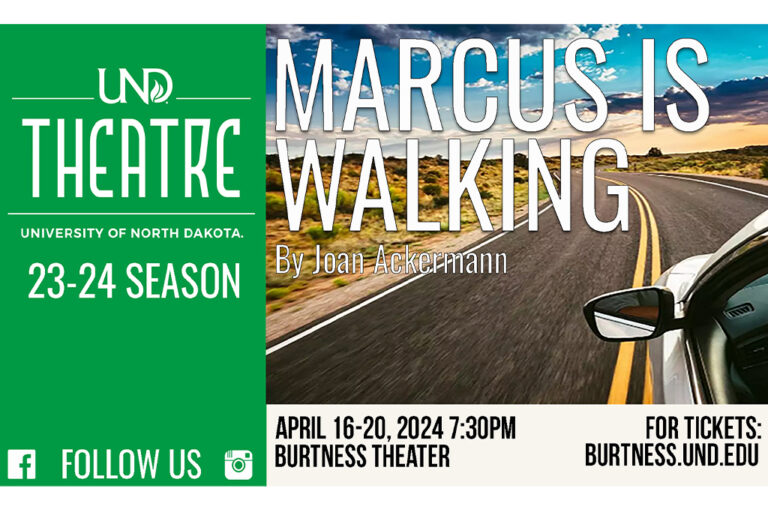Marathon math
Recognizing today’s launch of the annual ‘Wild Hog’ road races, we chat with UND mathematicians who use data and statistics to bust running myths

In the coming days, the Greater Grand Forks community will be stretching its hamstrings, crafting new music playlists, and loading up on carbohydrates.
Wild Hog Marathon weekend is finally here, and while some are monitoring the miles they’ve run or the seconds they’ve gained, a team of UND mathematicians will be running another set of numbers – hoping to make the next set of races even more competitive.

Jeremiah Bartz is an assistant professor in the UND math department. When he’s not crunching numbers, you may find him out jogging the trails or running competitively – and he’s found a way to connect the two sources of his happiness.
“This is actually a new field. You can intersect these two interests,” Bartz explained of his latest research endeavor. “I understand most of the running lore from being around racing and running as a hobby.”
Bartz has partnered with Mathematics Chair Gerri Dunnigan and Associate Chair Michael Minnotte to examine common-held beliefs about running, and whether they are rooted in statistical fact.
“We have large data sets from some races, and we’re looking at trying to debunk or confirm or suggest that common running lore is true or not true,” Bartz said. “Right now it’s just exploratory, but there’s getting to be more and more data out there, and they need researchers to explore it to see if we can learn anything from it.”
Running analytics
Bartz’s research partnership with Dunnigan started before he even had a chance to set up his office.
“When Jeremiah was interviewing, I said if he got the job, I wondered if he’d be interested in doing any sports analytics research together,” Dunnigan said. “It’s a hot field right now. Not only can you do some work in it, and maybe get a publication, but it’s something that’s fun, too, if you enjoy the sport.”
The team will be looking for particular falsehoods concerning running and how they can use statistics to comprehend what is really going on under foot.
Dunnigan said as a statistician, analyzing numbers is what she does, and applying statistics to this particular type of data is interesting and challenging. “But I think a lot of it is our desire for more understanding of what the data is telling us, and how our work might help a runner improve,” she said.
One area Bartz has had interest in exploring is split times for distance runners. The question at hand: is it best to run an even split (the same pace for the first half and second half of a race), a negative split (a faster second half), or a positive split (a faster first half)?
“It’s lore in the running world that you should try to run an even or negative split,” Bartz explained. “Some of those racing strategies have been addressed by coaches, but they haven’t really been framed from a mathematical perspective.”
The math team will also study data surrounding the right time to burst away from the pack, and how a runner can more effectively keep pace when their body is telling them to slow down. But those questions are only the beginning of what they hope to answer.
“What’s neat about some of the data sets that are coming out is that you really get the data for all of the participants now,” Bartz said. “More has been studied on the elite perspective, but what about the middle-of-the-packers or those at the back of the pack?”
Industry research
Both Bartz and Dunnigan attended this summer’s Great Lakes Analytics in Sports Conference in Wisconsin – Bartz as a presenter. He shared his expertise in marathon performance factors, pacing strategies and world records progression.
But he said the dialogue that is sparked at these conferences impacts more than individual athletes. In fact, the data discussion can mold the way the sports industry does business.
“For example, with running, it impacts race organizers,” Bartz said. “If you can understand the dynamics of your runners, you know not only numbers for quantity of supplies for aid stations and medical personnel, but it also impacts understanding your events. It helps you determine security, traffic control and other event aspects, so it can be helpful.”
Although the growing focus on sports data analytics could lead to dramatic advancements on the track, pool, court and ice, Bartz and Dunnigan say it’s important for athletes to keep their personal success in perspective.
“Don’t sweat the numbers,” Dunnigan said. “People can get really hung up on improving. With the lore, if something doesn’t seem to be matching up with what they think it should be, they shouldn’t let it bother them.”
Bartz, having been in those running shoes many times before, agrees – and has some advice for this weekend’s rookie and veteran runners. “Have fun and enjoy it. Enjoy the race and the whole experience of getting out there.”


